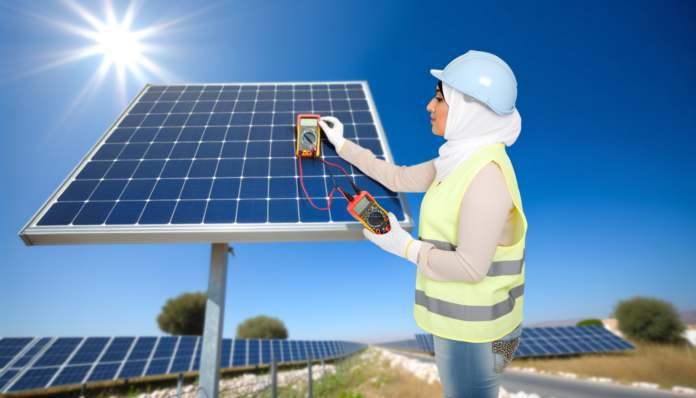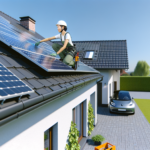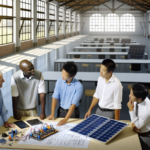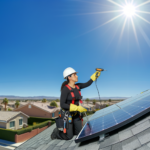Introduction to Solar Power
The Rise of Solar Energy
The adoption of solar energy has seen a remarkable rise over the past few decades. Initially, solar power was primarily used for small-scale applications such as calculators and remote homes. However, advancements in technology and significant reductions in the cost of solar panels have led to widespread adoption. Today, solar power contributes to over 6% of the world’s electricity, a substantial increase from just 1% in 2015. This growth is driven by both residential rooftop installations and large-scale photovoltaic power stations. The International Energy Agency (IEA) predicts that solar energy will continue to play a crucial role in the global energy mix, especially as countries strive to meet climate change targets and reduce their reliance on fossil fuels.
Benefits of Solar Power for Outdoor Enthusiasts and Off-Grid Living
Solar power offers numerous benefits, particularly for outdoor enthusiasts and those living off-grid. Here are some key advantages:
- Energy Independence: Solar power allows individuals to generate their own electricity, reducing dependence on the grid and providing a reliable energy source in remote locations.
- Environmental Impact: Solar energy is a clean, renewable resource that reduces carbon footprints and minimizes environmental impact compared to traditional fossil fuels.
- Cost Savings: While the initial investment in solar panels can be significant, the long-term savings on electricity bills and potential government incentives make it a cost-effective solution.
- Versatility: Solar power systems can be tailored to various needs, from small portable panels for camping to comprehensive setups for off-grid homes.
For outdoor enthusiasts, portable solar panels can power essential devices such as GPS units, smartphones, and camping lights, enhancing the overall experience. For those living off-grid, solar power provides a sustainable and reliable energy source, ensuring access to electricity even in the most remote areas.
Common Solar Power Systems and Components
Understanding the common components of solar power systems is essential for troubleshooting and maintenance. Here are the primary elements:
- Solar Panels: These are the most visible components, converting sunlight into direct current (DC) electricity using the photovoltaic effect. Panels are typically made of silicon cells and come in various configurations, including monocrystalline, polycrystalline, and thin-film.
- Inverters: Inverters convert the DC electricity generated by the solar panels into alternating current (AC) electricity, which is used by most household appliances. There are different types of inverters, including string inverters, microinverters, and hybrid inverters.
- Batteries: Battery storage systems store excess electricity generated by the solar panels for use during periods of low sunlight or at night. Common battery types include lead-acid, lithium-ion, and flow batteries.
- Charge Controllers: These devices regulate the voltage and current coming from the solar panels to the batteries, preventing overcharging and ensuring optimal battery health.
- Mounting Systems: Mounting systems secure the solar panels to rooftops, ground mounts, or other structures. They are designed to withstand various weather conditions and optimize the angle of the panels for maximum sunlight exposure.
- Monitoring Systems: These systems track the performance of the solar power system, providing real-time data on energy production, consumption, and system health. Monitoring can be done through dedicated displays or mobile apps.
By understanding these components, users can better diagnose and address common issues that may arise with their solar power systems, ensuring efficient and reliable operation.
Identifying Common Solar Power Issues
Understanding Solar Panel Efficiency Loss
Solar panel efficiency can degrade over time due to various factors. One of the most common issues is the accumulation of dirt, dust, and debris on the surface of the panels, which can block sunlight and reduce energy output. Shading from nearby trees or buildings can also significantly impact efficiency. Additionally, physical damage such as cracks or scratches on the panels can impair their ability to generate electricity. Over time, solar panels naturally degrade, losing a small percentage of their efficiency each year. This degradation is typically around 0.5% to 1% per year, depending on the quality of the panels and environmental conditions.
Battery Storage Problems
Battery storage systems are crucial for storing the energy generated by solar panels for use during non-sunny periods. However, these systems can encounter several issues. One common problem is the loss of battery capacity over time, which reduces the amount of energy that can be stored. Improper charging and discharging practices can also lead to reduced battery life and efficiency. For instance, consistently overcharging or deep discharging the batteries can cause permanent damage. Additionally, environmental factors such as extreme temperatures can affect battery performance and longevity. Regular maintenance and monitoring are essential to ensure the health and efficiency of battery storage systems.
Inverter Malfunctions
Inverters are responsible for converting the direct current (DC) generated by solar panels into alternating current (AC) that can be used by household appliances. Inverter malfunctions are a common issue in solar power systems. These malfunctions can be caused by several factors, including overheating, electrical surges, and component wear and tear. Common inverter errors include grid faults, over-voltage, and under-voltage conditions. In some cases, a simple reset or reboot of the inverter can resolve the issue. However, persistent problems may require professional diagnosis and repair. Regular monitoring and maintenance can help prevent inverter malfunctions and ensure the smooth operation of the solar power system.
Wiring and Connection Issues
Wiring and connection issues can significantly impact the performance of a solar power system. Loose or corroded connections can lead to intermittent power loss or reduced efficiency. Over time, exposure to the elements can cause wiring insulation to degrade, leading to short circuits or electrical faults. Regular inspection of the wiring and connections is essential to identify and address any issues before they cause significant problems. Testing for continuity and voltage can help ensure that all connections are secure and functioning correctly. In cases where wiring is found to be faulty, it should be replaced promptly to maintain the integrity and performance of the solar power system.
Troubleshooting Solar Panel Efficiency Loss
Diagnosing Dirty or Shaded Panels
One of the most common reasons for a drop in solar panel efficiency is dirt or shading. Dust, bird droppings, leaves, and other debris can accumulate on the surface of the panels, blocking sunlight and reducing their ability to generate electricity. Similarly, shading from nearby trees, buildings, or other obstructions can significantly impact performance.
To diagnose this issue, visually inspect your panels regularly. Look for any obvious signs of dirt or shading. If you notice dirt, clean the panels with water and a soft brush or cloth. Avoid using harsh chemicals or abrasive materials that could damage the surface. For shading issues, consider trimming trees or relocating obstructions if possible. In some cases, repositioning the panels might be necessary to ensure they receive maximum sunlight throughout the day.
Checking for Physical Damage
Physical damage to solar panels can also lead to efficiency loss. This damage can occur due to severe weather conditions, such as hailstorms, or from accidental impacts. Cracks, chips, or other forms of damage can disrupt the flow of electricity within the panel, reducing its overall output.
To check for physical damage, perform a thorough visual inspection of each panel. Look for any signs of cracks, chips, or other abnormalities. If you find any damage, it’s crucial to address it promptly. Small cracks might be repairable, but more significant damage may require replacing the affected panel. Always consult with a professional to assess the extent of the damage and determine the best course of action.
Assessing Age and Degradation
Solar panels naturally degrade over time, leading to a gradual decrease in efficiency. This degradation is typically due to the wear and tear of materials and exposure to environmental factors. Most solar panels come with a warranty that guarantees a certain level of performance for a specific number of years, often around 25 years.
To assess the age and degradation of your panels, review the manufacturer’s warranty and performance specifications. Compare the current output of your panels to the expected output based on their age. If you notice a significant drop in efficiency that exceeds the expected degradation rate, it might indicate an underlying issue that needs addressing.
In some cases, degradation can be accelerated by factors such as poor installation, subpar materials, or extreme environmental conditions. Regular maintenance and monitoring can help mitigate these effects and extend the lifespan of your panels. If your panels are nearing the end of their expected lifespan, it might be time to consider upgrading to newer, more efficient models.
By diagnosing dirty or shaded panels, checking for physical damage, and assessing age and degradation, you can effectively troubleshoot and address common causes of solar panel efficiency loss. Regular maintenance and proactive measures will help ensure your solar power system continues to operate at its best, providing you with reliable and sustainable energy for years to come.
Addressing Battery Storage Problems
Identifying Battery Capacity Issues
Battery capacity issues are a common problem in solar power systems, often manifesting as a reduced ability to store and deliver energy. This can be due to several factors:
- Age and Degradation: Over time, batteries naturally degrade, losing their ability to hold a charge. This is particularly true for lead-acid and lithium-ion batteries, which have a finite number of charge-discharge cycles.
- Temperature Extremes: Batteries are sensitive to temperature. Extreme cold can reduce their capacity, while extreme heat can accelerate degradation.
- Overcharging and Deep Discharging: Consistently overcharging or deeply discharging batteries can significantly reduce their lifespan and capacity.
To diagnose capacity issues, regularly monitor the battery’s performance metrics, such as voltage and state of charge (SoC). If you notice a significant drop in performance, it may be time to replace the battery or consult a professional for further diagnostics.
Ensuring Proper Charging and Discharging
Proper charging and discharging are crucial for maintaining battery health and efficiency. Here are some best practices:
- Use a Quality Charge Controller: A good charge controller ensures that the battery is charged and discharged within safe limits, preventing overcharging and deep discharging.
- Follow Manufacturer Guidelines: Always adhere to the manufacturer’s recommendations for charging and discharging cycles. This includes maintaining the recommended voltage levels and avoiding extreme SoC levels.
- Temperature Management: Ensure that the battery operates within the recommended temperature range. Some advanced systems come with built-in temperature management features.
By following these practices, you can extend the lifespan of your battery and ensure it operates at peak efficiency.
Maintaining Battery Health
Maintaining battery health is essential for the long-term reliability of your solar power system. Here are some tips:
- Regular Inspections: Periodically inspect the battery for signs of wear and tear, such as corrosion on terminals or physical damage. Clean the terminals to ensure good electrical connections.
- Equalization Charging: For lead-acid batteries, perform equalization charging periodically. This process balances the charge across all cells, preventing sulfation and extending battery life.
- Monitor Performance: Use a battery monitoring system to keep track of key performance indicators like voltage, current, and SoC. This helps in early detection of potential issues.
- Proper Storage: If the battery is not in use for an extended period, store it in a cool, dry place and maintain a partial charge to prevent self-discharge and sulfation.
By implementing these maintenance practices, you can ensure that your battery remains in good condition, providing reliable energy storage for your solar power system.
Resolving Inverter Malfunctions
Recognizing Common Inverter Errors
Inverters are critical components in solar power systems, converting the direct current (DC) generated by solar panels into alternating current (AC) used by most household appliances. However, they are also prone to various malfunctions. Recognizing common inverter errors is the first step in troubleshooting.
1. **Error Codes and Indicators**: Most modern inverters come with digital displays that show error codes. Common errors include:
– **Overload**: This occurs when the inverter is asked to supply more power than it is rated for.
– **Overheating**: Inverters can overheat if they are placed in a poorly ventilated area or if they are overworked.
– **Grid Fault**: This error indicates issues with the grid connection, such as voltage fluctuations or frequency mismatches.
– **DC Isolation Fault**: This error suggests a problem with the DC side of the system, often related to earthing issues or parasitic capacitance.
2. **Physical Indicators**: Apart from error codes, physical signs such as unusual noises, excessive heat, or a complete shutdown can indicate inverter problems.
Resetting and Rebooting Inverters
Sometimes, inverter issues can be resolved by simply resetting or rebooting the device. Here’s how to do it:
1. **Soft Reset**: This involves turning off the inverter and then turning it back on. Most inverters have a power button or a switch for this purpose. A soft reset can clear minor glitches and restore normal operation.
2. **Hard Reset**: If a soft reset doesn’t work, a hard reset might be necessary. This involves disconnecting the inverter from both the solar panels and the battery storage system. Wait for a few minutes before reconnecting everything. This can help in clearing more persistent issues.
3. **Firmware Update**: Some inverters allow for firmware updates. Check the manufacturer’s website for any available updates that might fix known issues.
When to Seek Professional Help
While many inverter issues can be resolved with basic troubleshooting, some problems require professional intervention. Here’s when to call in the experts:
1. **Persistent Errors**: If error codes persist even after resetting the inverter, it’s time to consult a professional. Persistent errors could indicate deeper issues that require specialized tools and knowledge to diagnose and fix.
2. **Physical Damage**: If the inverter shows signs of physical damage, such as burnt components or a damaged casing, do not attempt to fix it yourself. Physical damage can pose serious safety risks.
3. **Complex Issues**: Problems like DC isolation faults or grid faults often require a thorough inspection of the entire solar power system. Professionals can perform detailed diagnostics and ensure that all components are functioning correctly.
4. **Warranty Considerations**: If your inverter is still under warranty, attempting to fix it yourself might void the warranty. Always check the warranty terms and consider professional help to avoid any complications.
In conclusion, while recognizing common inverter errors and performing basic resets can resolve many issues, knowing when to seek professional help is crucial for maintaining the efficiency and safety of your solar power system.
Fixing Wiring and Connection Issues
Inspecting for Loose or Corroded Connections
One of the most common issues in solar power systems is loose or corroded connections. These can lead to inefficiencies, power losses, or even complete system failures. Regular inspection of all connections is crucial to ensure the system operates optimally.
Start by visually inspecting all accessible connections. Look for signs of corrosion, which often appears as a greenish or whitish residue on metal parts. Corrosion can occur due to exposure to moisture or salt, especially in coastal areas. Loose connections can often be identified by a simple wiggle test; if any component moves more than it should, it needs tightening.
Use a screwdriver to tighten any loose screws or bolts. For corroded connections, first, disconnect the power to avoid any electrical hazards. Clean the corroded parts using a wire brush or sandpaper until the metal is shiny again. Apply a corrosion inhibitor to prevent future issues before reconnecting and tightening the components.
Testing Continuity and Voltage
After ensuring all connections are tight and free of corrosion, the next step is to test for continuity and voltage. This helps confirm that the electrical path is complete and that there are no breaks or faults in the wiring.
Use a multimeter to test continuity. Set the multimeter to the continuity setting, and place the probes on either end of the wire or connection you are testing. A continuous beep indicates that the circuit is complete. If there is no beep, the wire may be broken or disconnected.
To test voltage, set the multimeter to the appropriate voltage range for your system (usually DC for solar power systems). Place the probes on the positive and negative terminals of the component you are testing. The reading should match the expected voltage for that part of the system. Significant deviations could indicate a problem with the wiring or the component itself.
Regularly testing continuity and voltage can help identify issues before they lead to more significant problems, ensuring your solar power system remains efficient and reliable.
Replacing Faulty Wiring
If you identify any faulty wiring during your inspections or tests, it is crucial to replace it promptly to maintain the integrity of your solar power system. Faulty wiring can cause power losses, inefficiencies, and even pose a fire hazard.
First, ensure the power is completely disconnected from the section of the system you will be working on. Use wire cutters to remove the damaged section of the wire. Strip the insulation from the ends of the new wire using a wire stripper, exposing enough metal to make a secure connection.
Connect the new wire to the system using appropriate connectors or terminals. Ensure the connections are tight and secure, and use electrical tape or heat shrink tubing to insulate the connections. This prevents moisture ingress and reduces the risk of short circuits.
After replacing the faulty wiring, test the system again for continuity and voltage to ensure the new wire is functioning correctly. Regular maintenance and prompt replacement of faulty wiring can significantly extend the lifespan of your solar power system and improve its overall performance.
By following these steps, you can effectively troubleshoot and resolve common wiring and connection issues in your solar power system. Regular inspections, testing, and maintenance are key to ensuring your system operates efficiently and reliably, providing you with clean, renewable energy for years to come.
Preventive Maintenance and Best Practices
Regular Cleaning and Inspection
Maintaining the cleanliness of your solar panels is crucial for optimal performance. Dust, dirt, bird droppings, and other debris can accumulate on the surface, significantly reducing the panels’ efficiency. **Regular cleaning** ensures that the panels receive maximum sunlight. Use a soft brush or a sponge with soapy water to clean the panels gently. Avoid using abrasive materials that could scratch the surface.
In addition to cleaning, **routine inspections** are essential. Check for any signs of physical damage, such as cracks or chips, which can affect the panel’s performance. Inspect the mounting system to ensure that it is secure and free from rust or corrosion. Regular inspections can help identify potential issues before they become significant problems, saving time and money in the long run.
Monitoring System Performance
To ensure your solar power system is operating efficiently, it’s important to **monitor its performance** regularly. Many modern solar power systems come with monitoring software that provides real-time data on energy production and system health. This software can alert you to any anomalies or drops in performance, allowing you to address issues promptly.
**Key metrics to monitor** include:
– **Energy output:** Compare the actual energy production with the expected output based on your system’s specifications and local weather conditions.
– **Battery health:** Keep an eye on the charge and discharge cycles of your batteries to ensure they are functioning correctly.
– **Inverter performance:** Monitor the inverter’s status to ensure it is converting DC to AC power efficiently.
By keeping track of these metrics, you can quickly identify and troubleshoot any issues, ensuring your system operates at peak efficiency.
Staying Updated with Solar Technology
The solar power industry is continually evolving, with new technologies and innovations emerging regularly. Staying informed about the latest advancements can help you **optimize your system’s performance** and take advantage of new features and improvements.
**Ways to stay updated include:**
– **Industry publications and websites:** Subscribe to solar energy magazines, blogs, and websites to stay informed about the latest trends and technologies.
– **Professional organizations:** Join solar energy associations and attend conferences, webinars, and workshops to network with industry professionals and learn about new developments.
– **Manufacturer updates:** Keep in touch with your solar equipment manufacturers for updates on new products, software upgrades, and maintenance tips.
By staying current with the latest solar technology, you can ensure your system remains efficient and up-to-date, maximizing your investment in renewable energy.






